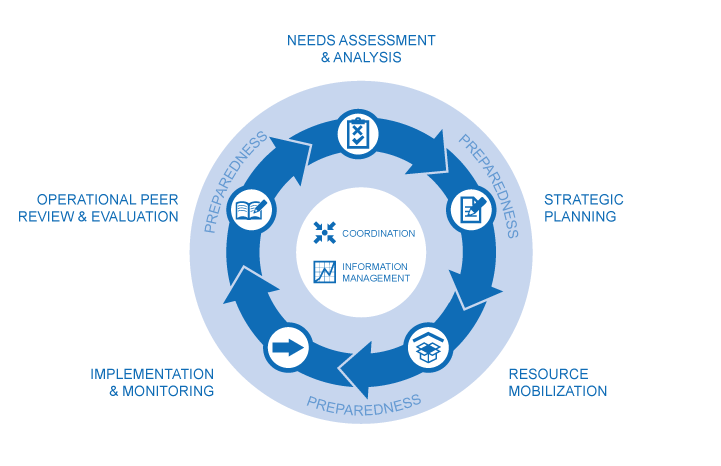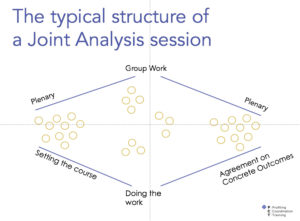Joint data analysis is increasingly moving centre stage in humanitarian practice, underpinned by the commitments made under the Grand Bargain to improve joint and impartial needs assessments. Similarly, speaking from our own experience in JIPS, joint analysis is a critical step in a profiling exercise: it helps ensure buy-in on the results from a critical mass of actors, all of whom need to work together to effectively address internal displacement. Key profiling stakeholders typically include government institutions and UN agencies, but also local and international NGOs and affected communities themselves.
At the same time, for many – profiling partners as well as the wider community of practitioners – it continues to be a struggle to grasp how exactly joint analysis works, why it is so important, and how they can benefit from it. This article is part of a series we launched earlier this year to foster a better understanding of data analysis approaches we use in profiling, in addition to learning from the wider humanitarian and development community in this area.
In our previous article on the subject we looked at the building blocks of joint analysis to lay the theoretical foundation. Here, we want to answer the question of how joint analysis is being effectively put into practice. Through conversations with partners who are also implementing joint analysis, we hope to share some concrete answers. This time around we talked to Nayana Das, Research Design Manager at IMPACT Initiatives, to exchange experiences on joint analysis in multi-sector needs assessments (MSNAs) and profiling of displacement situations, and to hear about their new guidance. Here’s what we learned:
– – –
Jonas Schelhorn: We understand that IMPACT is currently developing a guidance on joint analysis to help your country assessment teams implement MSNAs. Can you tell us why this guide was necessary and how you went about developing it?
Nayana Das: MSNAs involve multiple stakeholders as they are conducted within a strong partnership framework at inter-sectoral level. They are intended to inform humanitarian strategic planning and decision-making processes as well as cross-sectoral prioritisation along the humanitarian programme cycle (HPC), such as the Humanitarian Needs Overviews (HNO) and the Humanitarian Response Plans (HRP). In this context, jointly analysing the data is key to ensure buy-in among the diverse stakeholders and consensus on the final results.
But this is easier said than done. We came to realise this in 2018, when our teams were implementing MSNAs across eight countries. We needed clear guidelines and objectives on how to effectively implement joint analysis processes.

“The humanitarian programme cycle (HPC) is a coordinated series of actions undertaken to help prepare for, manage and deliver humanitarian response. It consists of five elements coordinated in a seamless manner.” Source: OCHA/Humanitarian Response.
Our teams had to co-facilitate joint analysis workshops as part of the MSNA process, and this was all happening on a larger scale and scope than usual. We (the IMPACT HQ Research department) started receiving quite a few queries for materials to help guide them through this process. Around this time, I was also about to start the ACAPS-led Humanitarian Analysis Programme (HAP) – to which JIPS contributed sessions on stakeholder engagement and joint analysis (1). The Head of our Research Department thought it might be a good opportunity to capitalise on this training programme to develop a practical guidance on joint analysis for MSNAs.
(1) The sessions facilitated by JIPS as part of the Humanitarian Analysis Programme, brought participants to work on how to map stakeholders and identify typical challenges, enablers and blockers of engagement. They looked at different ways to foster and sustain engagement, stakeholder roles within analytical workflows, and facilitation techniques.
Jonas: Sounds very familiar – we face similar challenges in profiling exercises, which, just as in MSNAs, involve bringing a diverse group of stakeholders around the table to jointly analyse data. This typically includes people with varying expertise and positions from local and national government authorities, development actors as well as the ‘usual suspects’ from the humanitarian community.
This requires bridging different viewpoints, combining diverse expertise (both thematic knowledge, e.g. housing and land tenure, and technical background, e.g. how familiar participants are working with data), and keeping groups with differing interests engaged throughout the process, among others. When effective, this can help bring all these views together, thus celebrating the diversity of such groups of partners instead of attempting to mitigate it, and it can foster agreement among stakeholders on the results and recommendations that follow from them and thereby help inform coordination of response.
When we were working on preparing the HAP training sessions, we realised just how little guidance there was on joint data analysis, beyond the experience and memories of team members who had facilitated them. How did you go about developing your guide for joint analysis in MSNAs?
Nayana: My starting point were the training materials from the HAP. During the first two weeks of the training, we had two whole days of presentations and exercises with JIPS colleagues on joint analysis and stakeholder engagement. This, together with some additional resources ACAPS shared with us, got me started.
I then also looked at resources on analysis more broadly speaking from other actors within the humanitarian and development sector as well as some additional literature on structured interpretative analysis techniques from ACAPS and government agencies, mainly from the U.S. I have also recently been in touch with you, Jonas, as you’re working on a fully-fleshed training module on joint analysis that can be flexibly integrated into partner training events.
Finally, we also wanted to make sure lessons learned in our field work were incorporated into the guidance, so I consulted minutes and relevant outputs from joint analysis workshops conducted for the Nigeria and Uganda MSNAs in 2018.
Jonas: When looking at the implementation of joint analysis, what in your experience from MSNAs are key success factors?
Nayana: I think for the planning and preparation phases, stakeholder engagement is key to ensure you have the right people in the room. At the same time, preparation of clear background materials, including an analysis plan, and preliminary analytical outputs, and sharing these in advance, is also important to ensure participants come prepared.
Jonas: From our experience it’s also critical to have a rigorous process that involves all partners from the beginning, to ensure that the analysis and methodology are agreed upon, but also to avoid misinterpretation of the data. For us, this includes reflecting on whom to invite, when and in what form to share the data, among others. This can be straightforward but in politically sensitive displacement contexts, it is not always easy to strike the right balance.

Isiss Sauceda, coordinator of the Commission for the Honduran Inter-institutional Commission for the Protection of Persons Displaced by Violence, during a JIPS-facilitated joint analysis workshop in February 2019.
In the case of Honduras, for instance, we prepared a list of key preliminary findings based on an initial exploratory and descriptive analysis, which then guided and structured the working sessions with profiling partners. Making sure beforehand that partners were clear about how the data was collected and thus how it could be interpreted (and what the limitations were) was critical for this work.
Nayana: And finally, I’d say good facilitation is also very important: the joint analysis session itself should be structured in a way that helps to follow the analysis process, i.e. going from description and explanation (What? How? Why?) to interpretation (So what?) and then conclusion (Now what?). This ensures the group has a chance to interpret and help contextualise the findings, and then together inform sectoral and cross-sectoral needs and priorities.
For example, for the Uganda MSNA last year, the team used breakout group discussions where each group discussed a specific theme or sector of the findings. Groups then came together in a plenary to present and discuss the conclusions from each of the specific themes/ sectoral findings.

The typical structure of a joint analysis session, inspired by the book: Sam Kaner et al. (2014): Facilitator’s guide to participatory decision-making, 3rd edition, Jossey-Bass, San Francisco.
Jonas: We used a similar approach in the case of the profiling exercise in Sittwe, Myanmar. The profiling coordinator organised a series of sector-specific workshops to bring together cluster experts from diverse partners and reach agreement on the results.
We would also add data communication to the list of key elements in effectively facilitating a joint analysis process: to ensure partners know how to read the data and understand its limitations. We use different methods to do so, inspired from other fields, such as joint decision-making techniques, or mediation approaches.
What comes next for IMPACT’s joint analysis guidance?
Nayana: We are planning to roll out the first version of the guidance by August 2019. This year we are implementing MSNAs in 11 countries, a substantial increase from last year. Naturally, it is impossible to create a one-size-fits-all guidance, but clear processes nonetheless mean that MSNA teams do not need to re-invent the wheel in each country on their own. Hopefully with the feedback we receive along with lessons learned from this year, we can work on a second version to be rolled out for future use.
Jonas: Thank you, Nayana, for sharing your work with us. We are definitely looking forward to hearing more from the roll-out and about your country teams’ experiences.
In JIPS, besides the thematic training module we are also working on a related guidance document that we’ll put up on the JET. We’d be interested to work together on next steps and continue the exchange to make Grand Bargain commitments a reality in practice.
This article was developed and adapted from a discussion with IMPACT’s Nayana Das and JIPS’ Svend-Jonas Schelhorn.
Are you also working on displacement data collection processes that involve joint analysis? Tell us more about your work at info@jips.org or on Facebook, LinkedIn or Twitter.